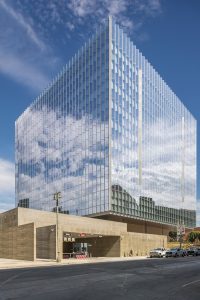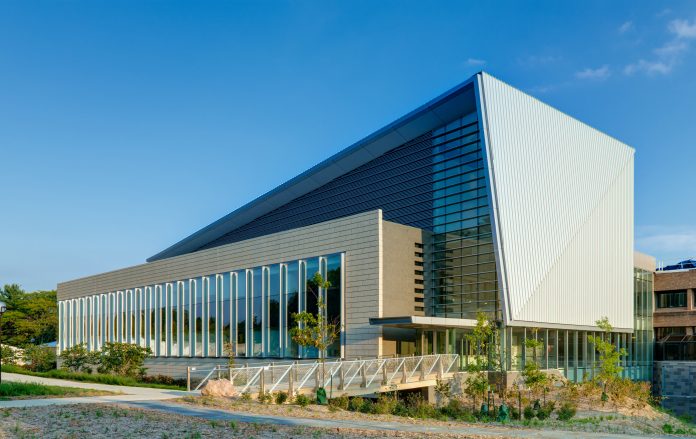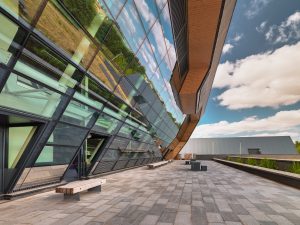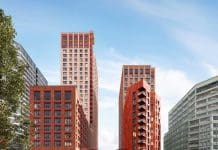Effective louvre specification requires more than just going with the (air)flow, says Andy Moul, technical support manager at Construction Specialities (CS)
Architectural louvre systems offer a simple and effective way of providing airflow to building systems. However, their specification requires a number of key considerations, beyond traditionally used but simplistic physical free area. Desired airflow performance, rain defence requirements and overall aesthetics have a part to play in a louvre systems selection. Only satisfying all project requirements will ensure the louvres fit and function as intended.
Although primarily installed to protect a building’s mechanical and electrical equipment from overheating due to insufficient air supply or damage resulting from rain ingress, louvres offer additional benefits. They help maintain natural airflow through a building, a process that is crucial to creating healthy interiors and limiting the increase of interior temperatures. A naturally ventilated environment helps facilitate year-round interior comfort and greater occupant contentment.
There are many louvre systems available, offering different performance characteristics. The simple and economical louvres utilising an essentially flat blade profile usually provide good airflow, but poor rain defence. They are therefore seen as an ideal solution where the primary function is vision screening.
Ventilation louvres, which offer high levels of free area and airflow with low pressure drop, are typically chosen when airflow is a key consideration. They may provide an adequate rain defence in light rain, but their performance generally falls short in wind-driven rain conditions.
When potential rain penetration is an issue, the high-performance louvre models with integral water collection and drainage should be considered. These systems are purposely designed to prevent wind-driven rain ingress into the building, while allowing good passage of air. This is achieved through either a complex single-blade profile extrusion to give a slim louvre depth or a deeper, multi-bank system. In all cases, performance louvres use an effect commonly referred to as ‘tangential separation’ to expel water from the airstream.
Louvres are an important part of a building’s overall make up, for their effective application, a balance between form and function must be struck when it comes to their specification.
Functional requirements
 Traditionally, louvres have been specified based on ‘free area’. This phrase simplistically relates to the gaps between blades in louvre design that facilitate airflow, but does not quantify airflow efficiency. Therefore, designers and service engineers should be placing more importance on the design pressure drop and aerodynamic airflow efficiency. This is a true indicator of a louvre’s performance, which ensures mechanical equipment has the required airflow to optimise function.
Traditionally, louvres have been specified based on ‘free area’. This phrase simplistically relates to the gaps between blades in louvre design that facilitate airflow, but does not quantify airflow efficiency. Therefore, designers and service engineers should be placing more importance on the design pressure drop and aerodynamic airflow efficiency. This is a true indicator of a louvre’s performance, which ensures mechanical equipment has the required airflow to optimise function.
Another important factor in terms of louvre selection is site location and position of louvres on the building, as exposure to prevailing weather conditions – in particular wind direction – will affect the amount of potential wind-driven rain and risk of water penetration.
Depending on a project’s functional requirements and available space, a differing design approach can be considered. Traditionally, a standard ventilation louvre installation with a wide plenum chamber behind it to collect and drain any ingress of water was used. The high-performance systems currently available allow for a more space-saving approach, whereby equipment such as HVAC systems can be located closer to the louvre opening without the worry of rain ingress.
When it comes to the selection of a high-performance louvre system, third-party test data should be examined to ensure a project’s functional requirements will be met. A British and European Standard, BS EN 13030:2001, was developed by the Building Services Research & Information Association (BSRIA), which enables specifiers to directly compare the performance of the different weather louvre systems available. The test uses fan-driven, wind simulation equipment propelling air towards the louvre at a 13m/s (30mph) velocity, and carrying water at a rate of 75l/h (litres per hour) per square metre of opening, to simulate rain. During the test, the air is drawn through the louvre at velocities from 0m/s to 3.5m/s (in 0.5m/s increments), to simulate demand from mechanical ventilation equipment.
The amount of rain that penetrates through the louvre is then measured and expressed as Penetration Class, with Class A indicating the most, and Class D the least effective louvre in terms of its rain defence performance. At the same time, the test evaluates the louvre’s airflow characteristics, which are averaged over a range of velocities and presented as a single Discharge/Entry Loss Coefficient, ranging from Class 1 (excellent airflow) to Class 4 (poor airflow). The resulting classification for the louvre system combines both performance aspects and should always be presented in relation to a specific face velocity, eg a louvre can be denoted as being Class A 2 up to 1m/s.
Another specification consideration, which can have a detrimental effect on occupants within or around public and commercial buildings, is noise pollution. Therefore, where soundproofing and airflow are simultaneously required to screen a plant room, for example, acoustic louvres are an ideal solution. These systems can be installed as standalone units or used behind other types of architectural louvres. They commonly range in depth from 150mm to 600mm, depending on the level of sound reduction performance offered. Therefore, appropriate provisions need to be made to accommodate and support these bulky and heavy modules.
All performance considerations such as required airflow, the maximum acceptable pressure drop, and the degree and depth of acceptable water penetration should therefore be balanced with the building’s envelope design – hence the need for a ‘form and function’ approach.
Mindful of design
Whether louvres are integrated into a building façade or used as simple vision screens on a roof, there is always an aesthetic requirement, as they need to provide a specific function while blending in or contrasting with the rest of the building envelope, depending on the design intent.
Louvres are available in a wide range of designs to suit different applications. A louvre system that uses hidden mullions, for example, will help achieve clean, continuous, architectural lines because the support system is behind the blades, making the mullions almost invisible. These types of louvres are often used where there are multiple or irregular openings on an elevation. The maximum length of a single blade is typically 4m (up to 6m max) due to transport and installation constraints. These louvre models are typically supplied in break down form and require site assembly.
Louvres with visible mullions, on the other hand, can be used as a design feature to line up with curtainwall panels or windows. Horizontal or vertical-spaced blades make up the body of a louvre panel to allow airflow. In performance louvres, these are installed as multiple banks of formed blades or as slimmer, complex blades designed to turn the air quickly while preventing rain ingress. The maximum length of the blade can go up to 3.5m. These systems are typically factory-assembled into complete modules, which makes site installation quicker and easier.
A horizontal blade configuration is the most commonly used arrangement, either with continuous blades or incorporating visible mullions as vertical breaks to align with other building elements. However, in terms of pure functionality in relation to wind-driven rain entry prevention, a vertical blade configuration will give the best results. This is due to the assistance of gravity in draining the water away from the face of the louvre quickly.
Some performance louvres can be shaped on plan to give curves, or the impression of a curve by using faceted panels. However, it is important to realise that their performance can be reduced, as the drainage characteristics of their complex blade profiles can be affected. If aesthetics are a major specification consideration, it is worth taking into account that as with anything customised or bespoke, there is always the likelihood of additional time and cost attachments.
To add interest to the façade, varying blade depths can be used with some louvre systems, or louvres can be hidden behind decorative features such as perforated panels – which can also act as bird guards. However, some of the features can potentially increase a louvre’s resistance to airflow, therefore appropriate test data should be checked to ensure a project’s functional requirements can be met.
Vision accomplished
Allowing ventilation into a building doesn’t have to compromise its aesthetic.
Louvres can help designers and engineers meet evermore demanding environmental legislation and client requirements for sustainable buildings through improving energy efficiency, lowering power consumption and thus reducing carbon emissions.
Andy Moul
Technical support manager
Construction Specialities
+44 (0)1296 794361
Twitter: @csgroupnews
LinkedIn: Construction Specialties UK Ltd
Instagram: @csgroupnews















